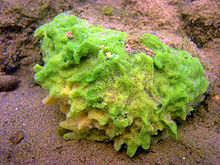User:Invertebratesarespineless/Spongilla lacustris
Spongilla Lacustris[edit]

Spongilla lacustris, also commonly referred to as fresh water sponge, is a species of freshwater sponges from the family Spongillidae. They inhabit freshwater rivers and lakes. Lacustris is from the latin word lacustris, meaning related to or associated with lakes.[1] It often grows under logs or rocks. It ranges from North America to Europe and Asia. It is the most common freshwater sponge in central Europe.[2] It is the most widespread sponge in Northern Britain, and is one of the most common species of sponges in lakes and canals.[3] They have the capability to reproduce both asexually and sexually. They become dormant during winter. It's growth form ranges from encrusting to digitate to branched depending upon the quality of the habitat.[4]
Classification[edit]
Spongilla lacustris is part of the class demosponges of the phylum Porifera. The Porifera phylum contains all sponges which are characterized by the small pores on the outer layer which intakes water. The cells in the sponge walls filter food from the water. That which is not uptaken by the sponge is pumped through the body out of a large opening. The class demosponges are the most abundant and diverse of the sponge classes. Some of the sponges in this class have skeletons made from silicon-containing spicules, spongin fibers or both. Marine and freshwater sponges are both a part of the demosponges. [5]
Reproduction[edit]

Freshwater sponges have two alternative methods of reproduction: asexually and sexually. There are two methods of asexual reproduction for this sponge.
Gemmalae: Gemmelae formation occurs during winter when the sponge goes into a dormant state. Cells, called archaeocytes, are created by the original sponge. These cells are surrounded by a gemmulae, or shell. The gemmulae protects the archaeocyte by allowing a high hydrostatic pressure which prevents repturing. When environmental conditions have improved the young sponge leaves the protection and starts a new animal.
Budding: The second asexual method is budding. This occurs in spring time when the sponges will form buds in its outer layer. These will eventually drift away from the original structure to form a new colony.
Sexual: The summer is when sexual reproduction occurs. These freshwater sponges are hermaphroditic meaning that it produces both sperm and egg. The sperm is released into the water where it will travel into another sponges ostia. The sponge will give birth to live, free swimming larvae after developing the sponges inner cavity.[6]
Habitats[edit]
Spongilla Lacustris are freshwater sponges and prefer shallow and clear waters. They are commonly found in ponds, lakes, and slow-moving waters. They can be found both under rocks and logs, covered from the sun, and on reedsand on rocks where there is more exposure.
Diet and Food Chain[edit]
Spongilla Lacustris are filter eaters that consume small floating organic particles. They are consumed by Sisyridae, a group of winged insects also known by the name sponge flies Their larvae act as parasites on the sponge and feeds exclusively on it during its larval period. Ceraclea are insects that not only feed on the sponges but will use their spicules to build hard, protective cases for themselves. [7] As the larva grows, it not only adds spicules to its casing but pieces of the sponge itself. When the ceraclea reaches adulthood and leaves the sponge, it carries and disburse fragments thus facilitating new sponge colonies.
Characteristics[edit]
Spongilla Lacustris can appear in several forms including, branching, clump like, or crust. On average the sponge grows to be a few inches in length. The color ranges from white to green depending on the amount of zoochlorella, a green algal tissue, available. The algal tissue has a symbiotic relationship with the freshwater sponges. The algae help facilitate oxygen and food uptake for the sponge while the sponge provides the algae a surface to live on.

The texture of the sponge itself is soft. The ostia (dermal pores) let water into the sponge to be filtered while the oscula is the hole in which water exits. Although the oscula is bigger then the ostia both are extremely small and difficult to see. Spicules cover the thin dermal membrane although the texture of the sponge itself is soft. The spicules are made of silica and provide structural support as well as protection. The freshwater sponges spicules come in many sizes and forms including emmula microscleres, parenchyma macroscleres, and microscleres.[8]
- ^ Cocchiglia, Letizia (2013). "Classification of Freshwater Sponge Collection at EPA Kilkenny" (PDF).
{{cite journal}}: Cite journal requires|journal=(help) - ^ http://www.waterwereld.nu/sponge.php
- ^ Evans, Karen (2019). "Freshwater sponge (Porifera: Spongillidae) distribution across a landscape: environmental tolerances, habitats, and morphological variation". Invertebrate Biology. 138 (3). doi:10.1111/ivb.12258.
- ^ Manconi, Renata (1991). "Life cycle of Spongilla lacustris (Porifera, Spongillidae): A cue for environment-dependent phenotype". Hydrobiologia. 220 (2): 155–160. doi:10.1007/BF00006548.
- ^ Wheeler, Kristen. "Demospongiae". Animal Diversity Web. Retrieved 2020-05-03.
- ^ Manconi, Renata; Pronzato, Roberto (1991-08). "Life cycle of Spongilla lacustris (Porifera, Spongillidae): a cue for environment-dependent phenotype". Hydrobiologia. 220 (2): 155–160. doi:10.1007/BF00006548. ISSN 0018-8158.
{{cite journal}}: Check date values in:|date=(help) - ^ Corallini, Carla; Gaino, Elda (2003-02). "The caddisfly Ceraclea fulva and the freshwater sponge Ephydatia fluviatilis: a successful relationship". Tissue and Cell. 35 (1): 1–7. doi:10.1016/s0040-8166(02)00086-1. ISSN 0040-8166.
{{cite journal}}: Check date values in:|date=(help) - ^ "Fig. 1. Spicules of Spongilla lacustris found in Iska River, subboreal..." ResearchGate. Retrieved 2020-05-03.
